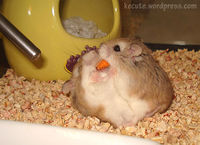Hamster Time!
Congratulations! You're the proud parent of a 5 or 6-year-old child who is longing for a pet. A child who is ready to start learning about how to care for and bond with another living being. A child who is ready to see the futility of life encapsulated in a small rodent running on a wheel without getting anywhere, day after day, week after week, month after month. Well, what better first pet for the child than a small, fragile rodent that will attempt escape at every chance and has a maximum life span of one or two years? That's right, it's Hamster Time!
Hamsters: An Overview[edit | edit source]
Hamsters are small rodents that weigh only several ounces, with stubby tails, soft fur, sharp little teeth, and paw-like little hands. They look fat and slow but are actually quite nimble and quick. They live well with other hamsters except when they get sick and kill each other. They do not live well with dogs or cats, as they tend to get eaten by these larger animals.
Hamsters as Pets[edit | edit source]
All of this being said, hamsters are truly amazing creatures with qualities that make them almost perfect first pets. While other prospective pets have some or most of the qualities that make hamsters so endearing, none provide the "complete package" that the hamster brings to the table. There are some downsides to hamster ownership (discussed later in this article), but overall, hamsters are great pets for kids!
Advantages of Hamster Ownership[edit | edit source]
First, hamsters have much in common with young children: they like to drink water and run around; they like to tear things like paper and cardboard apart; they like to put things in their mouths; and, they have grubby little paw-like hands that they like to lick and rub all over their own hair and bodies. Like small children, they also tend to relieve themselves in any place they find convenient, at any time that suits them. Hamsters and small children seem made for one another.
Second, hamsters are curious creatures with wills of their own. If children hit a dog, it will often come back for more. Not so with hamsters. Hamsters will make a run for freedom the first chance they get. With hamsters, children know the responsibility that comes with ownership. The animal had better stay locked in its cage or there won't be a pet around anymore. It's like owning a miniature feral cat, really. Hamsters teach children the rule that the things you love most must be treasured and imprisoned.
Third, hamsters have an energy and curiosity that staggers the imagination. Make sure that the hamster's cage is kept in your child's bedroom. Night after night, your child will be amazed to be woken up to the loud din of the hamster running on its hamster wheel for hours on end, or tearing through paper shavings to make a redundant "nest." Also, hamsters will tirelessly explore their surroundings and can learn to open their own cages and make a run for freedom. If your child is lucky enough to witness this feat, your child will have the privilege of seeing a creature with a pea-sized brain outwit a product of human engineering. Amazing!
Disadvantages of Hamster Ownership[edit | edit source]
In the interest of full disclosure, there are some downsides when pairing young children with hamsters. A child of 60 pounds outweighs his or her pet hamster on an exponential scale, and can crush the animal simply by holding it and squeezing too hard. Most small children are not known for the finesse or delicate treatment of others, so this can be a problem.
Also, because hamsters are fast and enjoy squeezing through tiny openings, they can and do often quickly evade their child masters and end up taking up residence the walls of the family home. They are not very fun as pets when they can no longer be seen or played with.
Lastly, hamsters do tend to die relatively quickly. They get sick easily and a two-year-old hamster is ancient by rodent standards. Unless your plan is to use the hamster to teach your child about the "circle of life," hamster ownership can be a trying experience.
Conclusion[edit | edit source]
Hamsters are fun and lively creatures that make excellent first pets for young children. Buy one for your child and watch the circle of life unfold before your child's very eyes! Remember, there's always time for Hamster Time!



